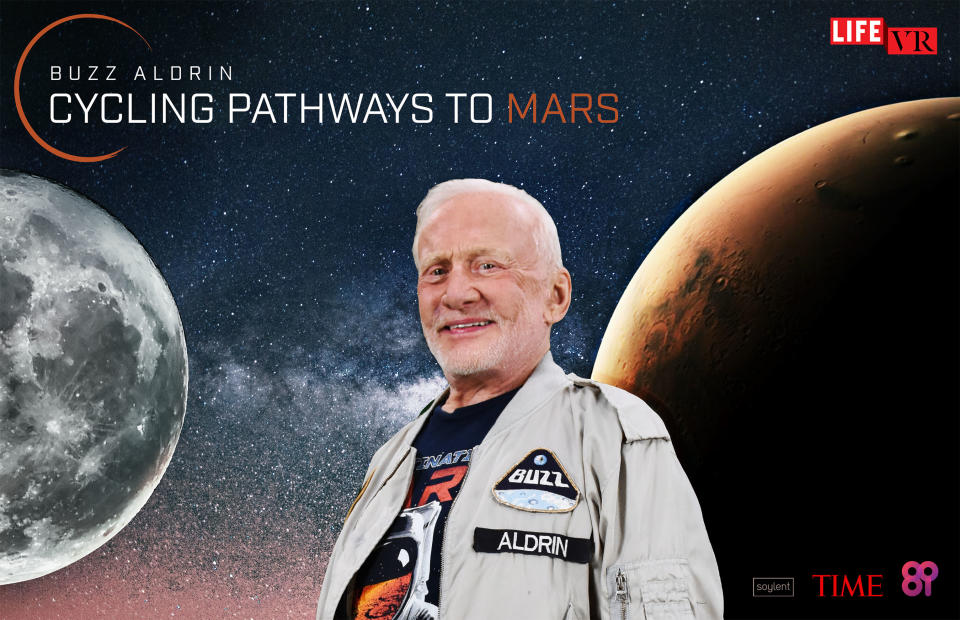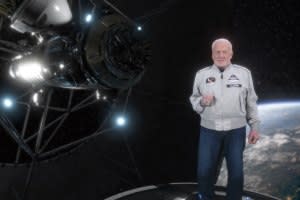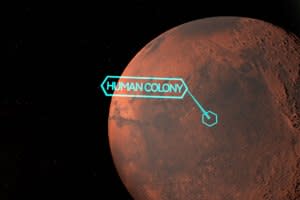Buzz Aldrin explains his new virtual-reality Mars experience
Buzz Aldrin has the distinct honor of being one of only 12 men who have ever walked on the moon. All these years later, he’s still got big plans. Aldrin wants NASA and modern space programs to build on his past achievements and take them further, all the way to Mars. But in Aldrin’s vision, humans won’t just walk on Mars or plant a flag there; they’ll build an entire, self-sustaining colony. This vision is fully laid out in Aldrin’s new virtual-reality experience for Life VR, Buzz Aldrin’s Cycling Pathways to Mars, which premiered at South by Southwest in Austin, Texas on Tuesday.
Cycling Pathways to Mars details a plausible pathway for getting humans to Mars within a few decades by building spacecraft to travel around orbit cycles. In an interview with EW, Aldrin explained how the idea built off his experience in the Apollo program.
“Back in the Apollo program, I knew that when we were going to the moon, there would be a free return potential if anything went wrong en route. If you didn’t make the maneuver, you just came back to Earth. That was the case on all Apollo flights,” Aldrin says. “I just kind of wondered, what would happen if we intentionally went around the moon, came back to the Earth, and then swung around the earth and went back out again? That’s an Earth-moon cycler, and I thought well, I know there are some other variations of that.”
As laid out in Cycling Pathways, this plan would first involve sending a craft to the moon to build a colony there for the purpose of building and fueling other crafts for longer journeys, such as to Mars. There are a lot of technical details involved, but luckily Cycling Pathways puts everything right in front of the user’s face. A hologram of Aldrin explains what’s happening while the user is transported to virtual-reality renditions of these proposed colonies for Mars and the moon. In doing so, it clarifies a lot of central concepts.
“I want young people to understand not just what the different spacecraft involved look like, but how we surface, how we refuel, how all these things progressively come together,” Aldrin says. “It is an overall plan, right from the very beginning, and it’s very important that we do not delay the beginning because it allows us to bring all the international partners together. Our participation is mostly technical: designing, doing a few initial construction projects, and then when things are operating, then the pool of the first Mars lander crew can go to the moon and continue assembling things at the moon, just like they will do at Mars. They’ll spend some time on the lunar surface to see what that loneliness and crew interactions are. But when they come back, the national program hopefully will not be to just to visit Mars, not just to keep it occupied, but to settle Mars.”
The original space race was born out of the Cold War and the titanic competition between the United States and the Soviet Union. This time around, Aldrin envisions greater international cooperation if humanity is ever going to make it to Mars.
“It is not just a group of people, but building a coalition of nations who know what they’re moving toward and improving and gaining more confidence,” Aldrin says. “Many people who are aware of the investments required will always say that no one nation could do all of this. I don’t see evidence of other projects that involve an enticement to bring partners together early in the planning so that we’re not competing in the operating tent. We’re coming up with the best designs and solutions of what it is we’re going to do. And then once we perfect that and everyone understands it, we’ll proceed to building pathways and way of cycling orbits between Earth and the moon.”
Buzz Aldrin’s Cycling Pathways to Mars goes public on LIFE VR March 17.



